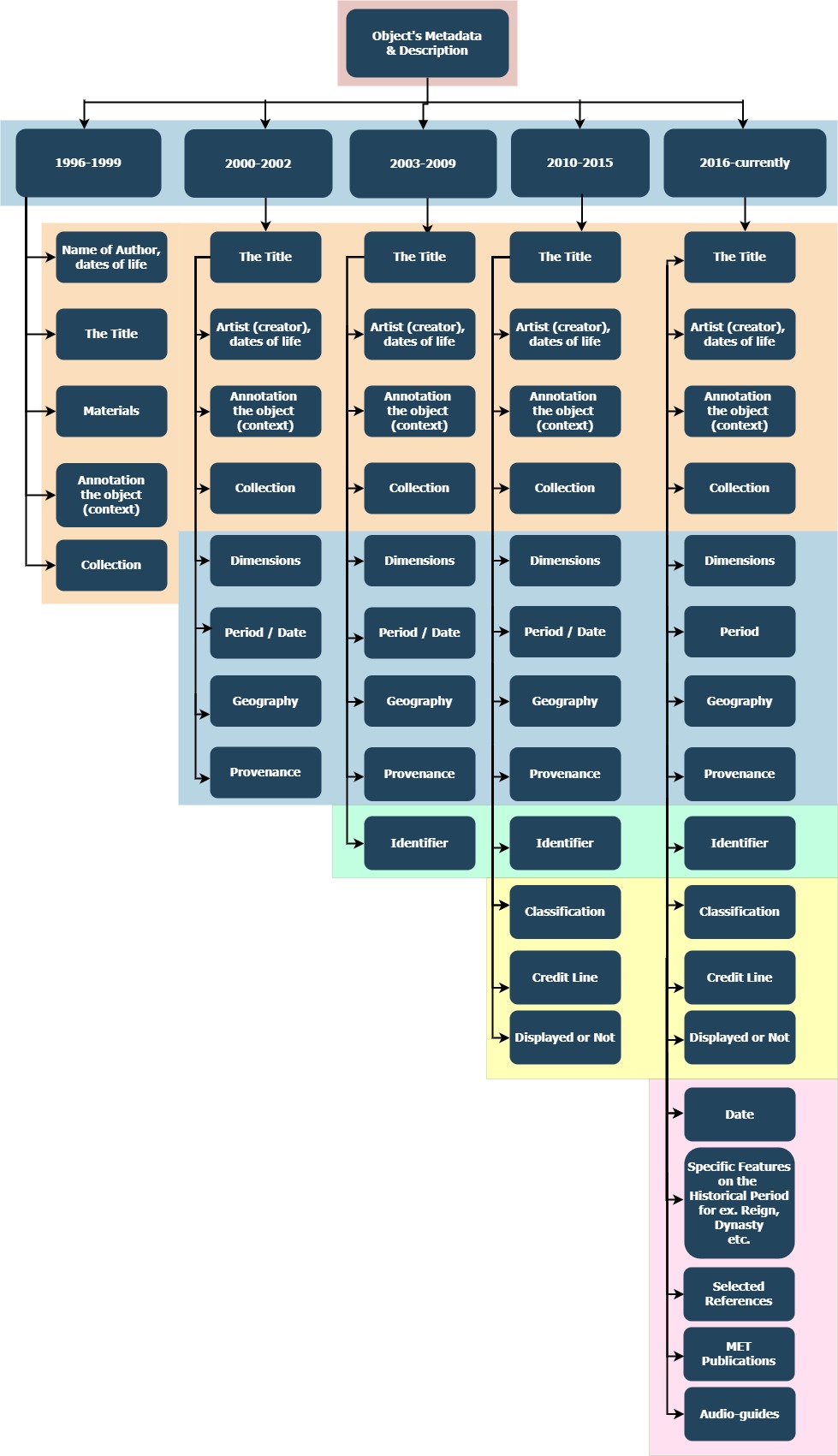The Metropolitan Museum of Art (New York, USA)
The Metropolitan Museum of Art (NY, USA) was found in 1870 and now the MET is one of the largest art museums in the world. MET is one of the first museums that began to actively use information technology in the museum. In 1968 the conference on “Сomputers and their potential applications in museums” was held at the Museum. The diverse experience accumulated by the museum over many decades laid the foundation for an interesting and actively developing electronic resource.
Home page as the face of a virtual museum
The main page of such a resource is important in terms of determining the priorities of the museum in the self-representation in a virtual environment. The snapshots of the main page show a shift in priorities from the exposition of the entrance to the actual museum’s building to the individual museum objects in the museum’s treasury. Then the central image is replaced by an illustration of the announcement of the main exhibition. The structure of the main page with the presentation of images of the three main ongoing exhibitions, with the sidebar on the left and information boxes below for a long time, becomes the main feature.
In 2015, the Artist project dedicated to the artists’ view of MET, presented exclusively in digital format, appears in a separate section on the museum’s main page. The existence of a visually highlighted block on the main page emphasizes the connection of a virtual resource and a real museum, the equal and full existence of an online resource. In the next year, on the main page, an image of a new online service #MetKids created by the museum specifically for children appears.







Digital Objects Representation
For a long time, the objects were presented in single copies and were necessary to illustrate the ongoing exhibitions. In the early history of the MET virtual museum, objects were presented in a single quantity, accompanying information about the exhibition. The objects were presented on separate pages using small photographs with a brief accompanying text about the exhibit and a brief historical context of its existence.
With the renewal of the presentation of digital collections in 2000, the presentation of objects in the collection changes, an expanded description appears, metadata includes not only information about the material and the period of the object’s creation, but also other data such as the creator, location, origin, way of appearing in the museum. The description of the subject is also expanded by describing the details and features of the object.
In 2012, the possibility of visualizing related objects was realized, although it was not finalized by the relevance to topics, since objects from other collections could be pulled up randomly, matching one of the fields in the description such as author, object type, geography (continent, country) or date. Therefore, the field with the offer for viewing often included objects whose connection with the main observed by the user object did not look so obvious. Subsequently, the algorithm was improved and offered more relevant objects for further viewing. In 2014, the possibilities for representing three-dimensional objects were expanded based on the presentation of a set of photographs of an object taken from different angles so that the user can get a more detailed observation of the object and it’s features.
In 2016, the extension of metadata and description of objects, complementing with references to publications and research (including the studies by the MET) helped to deepen the contexts of collection objects and expand the possibilities of their use in research and education. This model of representation of the object was complemented with audio-guides and it is maintained at the present day.



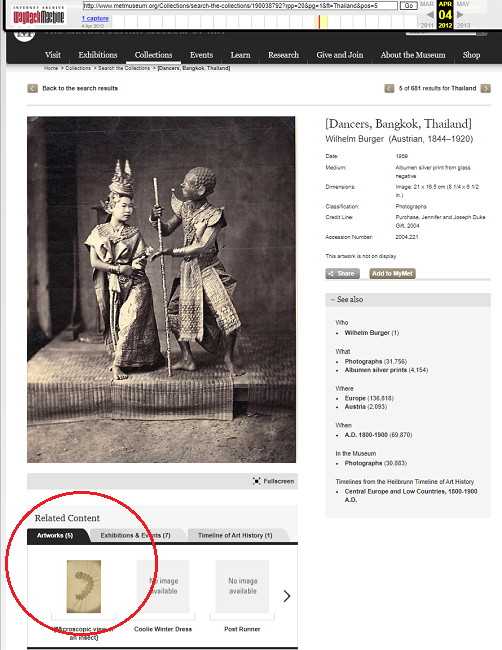



Digital Collections
Initially, the museum’s web resource performed exclusively reference functions, informing users about the museum, schedule and membership. However, as already seen in the first snapshots it is clear that information about online collections is appearing. Unfortunately, the web archive could not save information from the “Collections” section for 1996. Snapshots for 1997 show that the museum’s collections were strongly associated with a certain space of the museum, which hosts exhibitions on a particular topic. The “Collections” section shows the location of the exhibits in the museum, according to the presented building plan. Each section is accompanied by a brief description and presentation of one or several object from the exposition.
In 2000, the interface of the virtual museum was updated, including updates not only to its structure, but also fundamentally changing the approach to the presentation of collections. A search for collections appears, as well as the ability to save custom collections based on museum collections.
The increase in the number of objects in the digitized collections on the site was rapid and by 2011 reached 214,621 objects. For the convenience of users, the curators began to choose and offer objects highlighted by the curators for viewing, but developers also left a search function on the full database to access all the digitized objects of museum collections. In the 2010s approximately the same number of 1,500 artworks highlighted by curators was presented on the site.
Presentation of online collections was initially associated with the real museum building and rooms with expositions and then gradually turned into a neutral search form with a set of fields. Naturally, the collections are primarily connected with interesting and diverse objects of art to reinvigorate the public’s interest who is on the museum’s website in search of entertainment or inspiration for creativity. It is not surprising that the museum soon changeв its way of presentation of the collections and oriented them to non-expert communities, exposing the images of objects. Then the MET introduced the new opportunity to users to choose collections and objects according to the variety of topics, materials, geography or time of objects’ creation, accompanying each section with a unique visual raw and making the search flexible.
The MET has now returned to representing collections through a demonstration of individual art objects, accompained on the page with a search form and the opportunity to select and filter objects according to a wide range of characteristics, including features of an open licensing.












The dynamics of the publication of digitized objects on the site is reflected in the diagram below. There was rapid rise in the number of digitized materials in 2008-2012. It was caused by mass digitalization in the museum, when about a hundred thousand new materials were added to the online database annually. The recession after 2012 was associated with a revision of the policy regarding the submitted materials online and their transfer (mainly books, published materials and documents) to the library database. From 2014-2015 the museum has paid more attention to the quality of digitized materials and publishes high-resolution artwork.
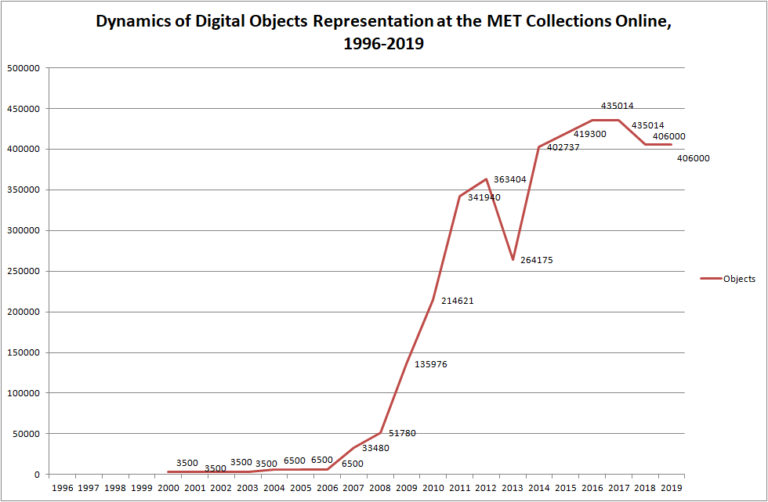
Digital Exhibitions
Since the time of the digital turn, the museum’s activities have been aimed at preserving information about past and past exhibitions, some of which have become significant and memorable events. An important feature of the early period of the history of the MET virtual museum was the preservation of ongoing exhibitions and the creation of special digital resources dedicated to them. The basis for one of these resources was the international exhibition “The Glory of Byzantium” (March 11 – July 6, 1997). The MET created a thematic resource on which the history of Byzantium was presented and illustrated by objects of Byzantine art of various forms and themes, as well as presented in a historical context. Such a resource has realized many educational and cognitive opportunities to get acquainted with the history of Byzantine art and individual masterpieces of this culture online. Then the structure of digital Byzantium resource began to be used for other online resources on ongoing exhibitions. This project became an exception among the exhibitions in the MET in terms of digital preservation of the exhibition’s meaning, ideas, and objects in cohesion with cultural and historical topics and issues. Further, the museum preferred to maintain the brief information about the exhibitions stored mainly in the form of archived announcements on the website. These announcements contained short movies about the exhibitions and links to the digital objects and now become an important source on the study of the museum history. Currently, the museum preserves the information on past exhibition and borrowed objects. So, some objects that are lent for exhibitions from other organizations are digitized, described and presented online in sections of web-site about past exhibitions. However, this approach does not allow us to trace the interconnectedness of objects and identify the whole idea of the exhibition through the web-archival research due to limitations of scanning the website.
It is surprising that the MET, experimenting in the field of VR in the early 2010s, did not continue the development of virtual tours. In 2001, the MET introduced a virtual reality tour. A special page on the website exposed for observation 6 museum rooms with reconstruction of historical American interiors that were created from colonial times to the beginning of World War I. However, it is difficult to evaluate the features of recreated virtual reality through a web archival snapshots due to the storage limitations for reproducing technically obsolete formats.







Digital Collections and Objects Visualisation. Linkage Data
The involvement of the audience of online users in the use of the resource was fueled by various means, and each of them solved and continues to solve the important issues that the museum faces. One of these important tasks is the organization of virtual environment, which allows visitor to observe the collections on an intuitive level, to search for the necessary objects and topics. To solve this issue, a search was carried out on objects and collections as it was mentioned before, however, other alternative ways of introducing visitors to the treasures of the museum were created. In 2000, TimeLine of Art History was launched, which combined the possibilities of visualization and the logical arrangement of objects on the chronological line. Thus, a long historical period of 5,000 years was presented on a scale and illustrated with objects from the museum. Subsequently, the timeline structure was complicated with new thematic layers, as well as various content formats, including audio and video materials. The interconnected components in the museum database, such as objects, collections, audio guides, publications and other additional materials contributed to the implementation of a dynamic model that covers the diverse needs of users searched for information.
At the moment, The Timeline of Art History demonstrates the linkage not only of the collections and objects of the museum, a variety of materials, essays and publications, but also external infusions from the ongoing and past exhibitions.

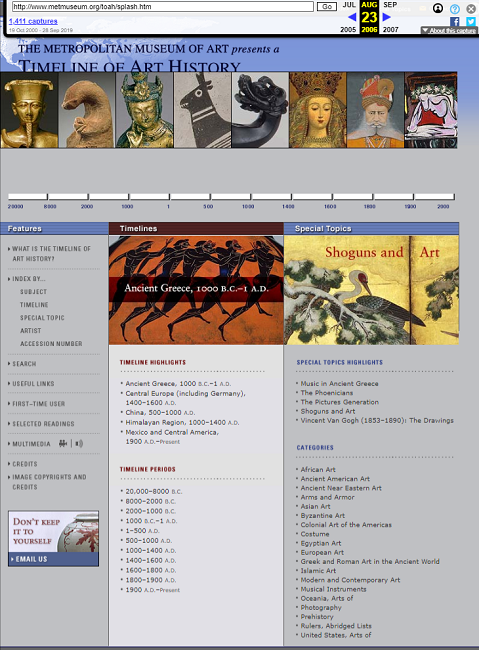



Engagement with Audiences Online. Education
Fairly quickly, the MET virtual museum began to contribute to the development of a digital educational environment based on museum materials, objects and collections. The educational direction of the museum’s activity can be divided into two parts. The first one is education in the field of art history through acquaintance with museum exhibits, a variety of topics and periods, types of historical and cultural heritage. On the other hand, the virtual museum offers materials for study related to the internal museum work and the main processes inside the museum, including conservation and study of provenance. The museum offered special content and ways of interaction with audiences online.
Since the advent of the virtual museum online, the site has provided educational sections on navigation through the educational resources of the site. A simple interactive game was created for children in the Question and Answer form, and a special section was also created to obtain the most basic knowledge of art. The section on introducing children to the study of art continues to expand in terms of content, and also includes a variety of new forms, mainly interactives such as charades, puzzles, quizes, and other games. The design and style of the fonts on the page with questionnaires about the museum, which may be of interest to children, refers to the shaping the environment that visually might attract children as well. Children remain one of the most important audiences through almost the quarter-century of the museum’s history online. The museum has created a specialized online environment for the study of art by children. In this way, various topics and entire resources were created, aimed at a children’s audience, telling stories in a lively and understandable way, illustrating with interesting objects from the museum’s collection. A section for teachers was created in late 1990s, which contained materials ready to be used at classes.
Special sections were created for a wider audience interested in art to obtain more detailed information about various masterpieces of art. That way museum storytelling is revealed on the website, which refers to the narrative about art-works, artists and topics about art. The visitors wanting to learn about the museum’s collections online were provided by special guides that have made navigation on a particular topic understandable and convenient. Such guides directed the visitor through the description of the collections to a variety of related digital exhibits, combining the visual row and textual narrative.
In the 2000s, the Explore & Learn section as a subdivision of Works Of Art was developed wider and deeper, expanding topics and the variety of forms of materials’ presentation. A subsection on Publications for educators included electronic publications and special digital resources created by the museum on diverse topics on art and its history. In 2010 this section was replaced with a Study & Learn section and put at the main menu of the web-site. This section combined information on the online activities and offline museum’s programs, which evidences the interpenetration of these processes in the museum’s activities, but complicates the understanding of the capabilities of the virtual environment. In the next years, the museum experimented with defining sections and subsections on the web-site, combining information in different ways. It should be noted that since 2012 the museum has been creating online resources, focusing on different audiences such as Kids, Teens, Adults, College Students, and Educators. Since 2013, a subsection has been created for Visitors with Disabilities, which contains mainly information about the museum’s activity offline.






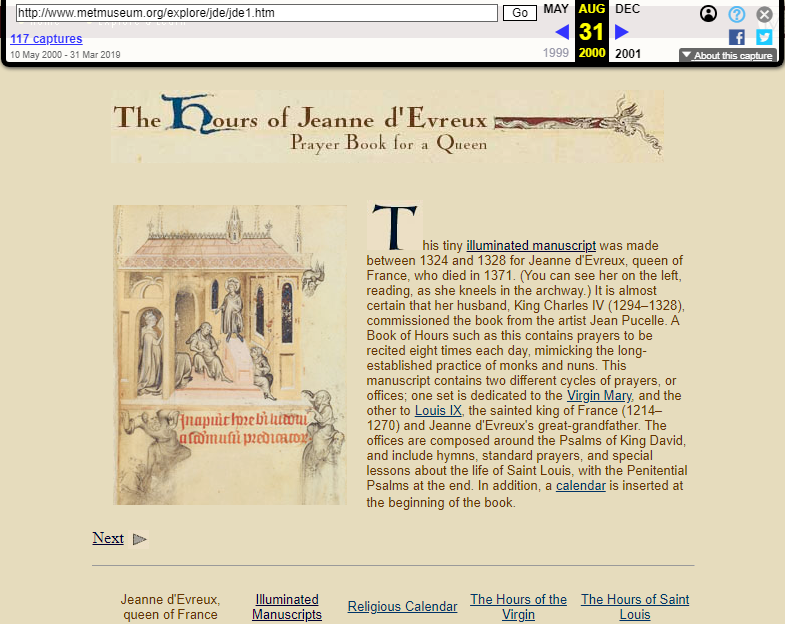





Summary
Thus, the Met Museum, having extensive experience in the application of information technology in various types of museum activities by the mid-1990s, was able to effectively imply this experience by creating and developing a museum web resource that became a virtual museum in its best sense of the term. The progress that the museum has made in the field of virtual museology shows that there have been periods of experimenting with forms, rather than following patterns. It is interesting that the museum, possessing wide resources and capabilities, avoided the dominance of VR-technologies in the online environment, systematically developing the virtual museum in other directions, aimed at different audiences. An important feature of the museum has been its orientation towards the development of a virtual museum as an educational resource, and thanks to a variety of ways to navigate content and ease of use, the resource could become user-oriented.
